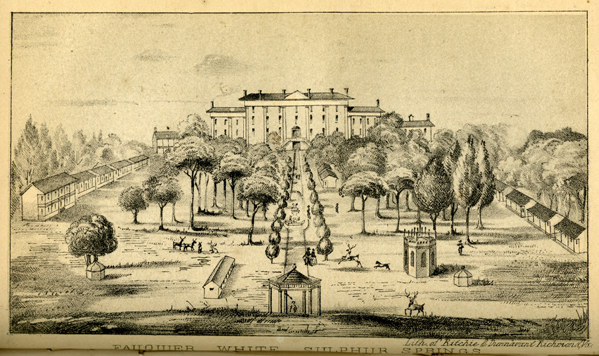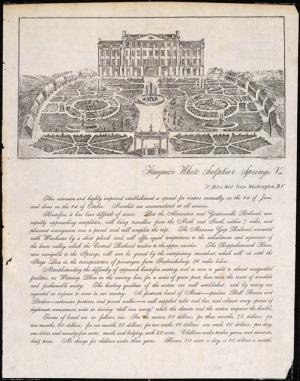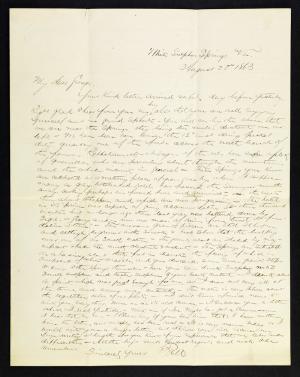Fauquier White Sulphur Springs
Fauquier County, Virginia
There is here a most comfortable Bathing establishment, which greatly enhances the advantages it presents in other matters, and those advantages must insure to this place a steadily increasing custom, and cause it to rank in point of numbers and fashion among the first of the Virginia Springs. William Burke

This lithograph shows the resort before the Civil War when two hotels and many of the cottages were burned. {1}
William Burke on the Fauquier White Sulphur Springs.
-300x198.jpg)
The Virginia Legislature moved to the Fauquier White Sulphur Springs in 1849 when there was a cholera outbreak in Richmond. This print depicts the resort in the mid 1850s. {2}
Fauquier White Sulphur Springs, located in Fauquier County, Virginia, was much appreciated in the neighborhood before it became a public resort. In his 1846 book Burke included a report stating that one man who owned the springs had suffered so many interruptions to the running of his farm that he filled up the spring. But eventually the land was acquired by Hancock Lee who with Thomas Green created “this most charming establishment.” Burke wrote that the improvements were “better calculated to promote the comfort and please the taste of visiters [visitors],” than any other watering-place in the state. The buildings could accommodate 800 guests and boasted of two, three and four story edifices. Appreciative of spacious and suitably furnished rooms, Burke did suggest that improvements could be made in the grounds. He was also disappointed in the “appearance of the table” which had a coarse cloth, chipped and broken china, dull and poorly cleaned tableware, and “other signs of a ‘falling off,’ which we could have wished had not been so palpable. We deem this miserable economy, and hope it has been corrected.” He surmised that no improvements of note had occurred since 1837 when the buildings and over 2900 acres of land were valued at $170,000.
Burke’s Recommendations for Using the Waters at Fauquier White Sulphur Springs.
Dr. Burke was not aware of any authentic analysis of the water but was satisfied that it was useful in dyspepsia, dropsy, and other diseases treated by sulphur water. He thought it could improve a torpid condition of the liver when given with blue mass, a preparation variously concocted but always with excessive amounts of mercury.
This broadside, probably printed in the mid 1840s, gives details concerning access to the springs by water, rail, and paved and plank roads. A resort for both “invalids and fashionable society” the healing waters were celebrated along with “almost every species of legitimate amusement.” Boarding rates varied depending on the length of stay and were $80 for the season and $1.75 per day for adults. Children from 3 to 12 and servants were charged half price. Horses cost 50 cents per day to board. {3}
Letter from Pell Manning to George O. Manning, August 25, 1863
Pell Manning gives his address as White Sulphur Springs, West Virginia, but since he mentions the Rappahannock River, his location is undoubtedly near the springs known variously as the Fauquier White Sulphur Springs, Warrenton Springs, or Lee Springs. Given that he was a Union soldier and only about 30 miles from the Virginia–West Virginia border, it may not be too surprising that he was mistaken as to which state he was in. He does a good job describing the ruins and the springs which are captured in the September 19, 1863 issue of Harper’s Weekly.
White Sulphur Springs WVa.
August 25th 1863
My dear George,
Your kind letter arrived safely day before yesterday. Right glad to hear from you my boy also that you are well, enjoying yourself and in good spirits. – You will see by the above, that we are near the Springs. they being two miles distant on our left. – We have been here since the 12th inst doing picket duty, guarding one of the fords across the north branch of the famous Rappahannock – No signs of the rebs. here save aplenty of guerrillas, who are prowling about through the mountains and the whole vicinity in general – These springs you know are celebrated as a watering place of years gone by, where I suppose many a gay, hot-headed rebel has passed the summer months away, cooling perhaps his fevered [brow] and ruminating over the events then about to happen, and which are now progressing –The hotel in its prime was capable of giving accommodation to three thousand visitors, but no longer ago than last year was battered down by Sigel, or [Gray] and is now one mass of ruins “from turret to foundation stone.” The massive granite pillars are still standing, and although begrimed with smoke & heat, show that the building was one of no small nature. – The premises about are shaded by magnificent shade trees, mostly chestnut & walnut. – The Springs are situated in a basin about thirty feet in diameter, the flooring of which is composed of white marble, and you descend some seven granite steps to [come] [within] springs themselves. – here you can drink sulphur water smell sulphur, and taste sulphur, to your hearts content. – I drank about a pint which was just enough for me, as I was not very ill at the time and came away contented. – The water is very blue, about the regulation color of our pants .…
Sincerely Yours Pell {4}
Additional Information:
- Use of Fauquier Springs by the Virginia Legislature in 1849: Fearful of the cholera outbreak affecting the Richmond area, the Legislature moved to the Fauquier Springs Hotel amid the public’s concern over the cost of the fashionable resort.
- Fauquier Springs Country Club history: This page and links from it mention Presidents James Madison and James Monroe who owned cottages at Fauquier, other famous visitors, the 1862 Civil War battle that resulted in the burning of much of the resort, and the 1943 purchase by Walter P. Chrysler.
- Library of Congress Prints & Photographs Online Catalog: Search for Fauquier Springs, and see nine images of Fauquier White Sulphur Springs and the vicinity, most taken by Timothy H. O’Sullivan in 1862. Included is one of the ruins of the hotel.
- Full text of Fauquier White Sulphur Springs, Virginia: Written for the 1882 season, this document relates the history of the springs, the accommodations and grounds as they were in the early 1880s, an analysis of the waters, certificates of cures, and accessibility.
Image Credits:
- {1} John J. Moorman, The Virginia Springs, Richmond, Virginia: J.W. Randolph, 1857: facing page [214]. Historical Collections & Services, Claude Moore Health Sciences Library, University of Virginia.
- {2} Merritt T. Cooke Memorial Virginia Print Collection, 1857-1907, Accession #9408, Special Collections, University of Virginia Library.
- {3} Fauquier White Sulphur Springs (Hotel: Fauquier County, Va.), Fauquier White Sulphur Springs Va.: 50 miles, west from Washington, D.C, [Fauquier County, Va.: Fauquier White Sulphur Springs, 1846?] Special Collections, University of Virginia Library.
- {4} Pell Manning Letter, Aug. 25, 1863, Accession #8435, Special Collections, University of Virginia Library.
Source:
- William Burke, The Mineral Springs of Western Virginia, New York: Wiley and Putnam, 1846.

